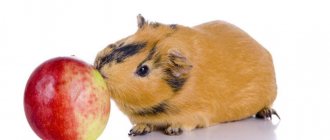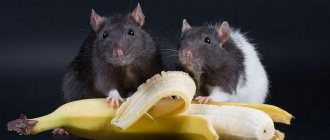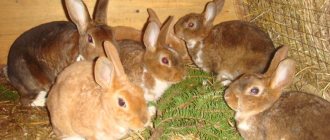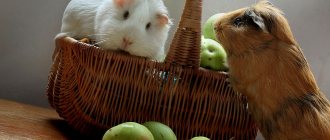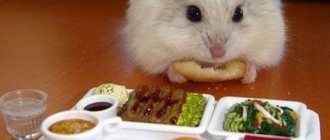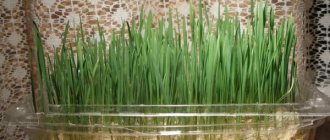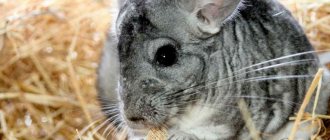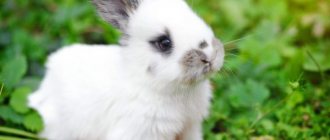- home
- Chinchilla
- Nutrition
04/01/2019 On the rocks where chinchillas live in the wild, vegetation is rather sparse.
However, the diet of rodents is varied: cereals, legumes, lichens, cacti and, of course, branches of shrubs and tree bark. When raising animals at home, in addition to vegetables, fruits and hay, you need to give chinchillas twigs. The food of rodents will be complete if you add young shoots and greens to the food in the summer and dried branches in the winter.
But first we need to find out which trees and shrubs are suitable for the animal to eat, as well as how to provide it with this food in the winter.
Recommendations for preparing branch feed
Shoots and twigs of various plants are introduced into the diet of animals for several reasons:
- Wood will add variety to the diet of an animal that is deprived of the opportunity to choose what it needs at any given time, as happens in its natural habitat. Greens and twigs are rich in vitamins, minerals and trace elements. This is a good addition to your pet's daily diet.
- Like other rodents, chinchillas' teeth grow continuously. They need to be sharpened. For this reason, the animal is always gnawing on something. Hardwood is a good choice for this. Otherwise, the chinchilla will chew everything it can, and this does not always please the owners.
- Any wooden object is perceived by your pet as a toy. You can encourage your pet to play with twigs and twigs. This will increase his interaction with you and he will become more sociable, active and trusting towards you.
Dried young shoots are a natural product with nutritional value similar to hay. It contains proteins, fats and lots of fiber. In industry, these raw materials are used to produce vitamin flour.
The branches are collected during the plant's growing season, when they contain the most nutrients.
Logging sites must be environmentally friendly. Forests are not suitable for waste collection if there are highways or industrial areas nearby. Also, you should not store tree feed within the city, even in parks.
The branches must be clean - free from mold, pests, fungi and signs of animal bites.
The bark contains beneficial substances in maximum concentration, so there is no need to clean it.
Rules for procurement of raw materials
The need to introduce various shoots and twigs into the diet of rodents is explained by several factors:
- saturating the pet’s body with vitamins and minerals;
- improving the functioning of the dental system;
- positive effect on the behavioral factor - chinchillas use branches as toys.
Features of harvesting green fodder at home:
- collection of branches is possible only in ecologically clean areas, far from highways, densely populated areas, industrial enterprises;
- the optimal time for collecting wood and foliage is the growing season;
- it is necessary to ensure the absence of moldy parts, lichens, traces of pests and fungi;
- At home, each rod must be rinsed successively with hot and cold water and dried;
- store in a place with minimal moisture content;
- the bark should be left on the rods - it contains the maximum concentration of useful substances.
Harmful branches for chinchillas
Some plants are not only not beneficial for rodents, but are actually prohibited for them:
- all coniferous trees and plants whose wood contains resin;
- Cherry, almond, plum, apricot and other fruit trees with seeds. The cyanide compounds present in them produce strong hydrocyanic acid (the strongest poison);
- all citrus fruits;
- sea buckthorn, elderberry, maple, cherry.
Introduce him to tree food gradually, observing his reaction to the new treat over several days. Not all pets eat branches of different plants with the same pleasure. Over time, you will learn your pet's preferences and be able to stock up on what he likes.
A chinchilla's diet should consist of more than just vegetables, fruits, grains, etc. It is necessary that the animal receives with food the substances necessary for the body, which are contained in various twigs, branches and cut branches.
But not every tree is suitable for the normal development of a rodent, and before planting any branches in the cage, you need to understand which trees can be chewed by chinchillas so as not to harm the animals.
Final table
It is quite difficult to immediately remember all the branches that are allowed and prohibited for feeding chinchillas. Therefore, to avoid mistakes and just for convenience, you can use a summary table of tree species that are useful and harmful for fluffies:
| Can | It is forbidden |
| Apple tree | Cherry |
| Pear | Cherries |
| Rowan | Plum |
| Currant | Apricot |
| Linden | Peach |
| Birch | Nectarine |
| Hazel | Cherry plum |
| Willow | Mandarin |
| Aspen | Orange |
| Elm | Lemon |
| Mulberry | Grapefruit |
| Willow | Pomelo |
| Alder | Spruce |
| Sea buckthorn | Larch |
| Raspberries | Pine |
| Gooseberry | Cedar |
| Kalina | Juniper |
| Rose hip | Fir |
| Hibiscus | Thuja |
| Hawthorn | Maple |
| Chestnut | Lilac |
| Acacia | Buckthorn |
| Elder | |
| Bird cherry |
Knowing which tree branches can be given to a chinchilla and which ones cannot, every owner will be able to protect their pet from health problems. If a mistake does occur and the animal gnaws on a stick of a prohibited breed, you must immediately contact a veterinary clinic. The specialist will examine the animal and prescribe appropriate treatment.
Rules for self-harvesting branches
As soon as buds appear on the trees, you can begin collecting branches. They are trimmed with pruning shears. The sap moving through the trees at this time contains the most valuable nutrients.
- Take only living branches from healthy trees and shrubs. Do not cut plants that are dry, dirty, moldy, or have animal teeth marks. The stems of raspberries, gooseberries and hawthorns should be cleared of sharp thorns so that the animal does not injure itself in the mouth.
- The twigs (about 1 cm in diameter) are divided into pieces 5-7 cm long. This size is convenient for chinchillas to eat while sitting and hold the treat in their front paws.
- Wash the cut branches well and scald them with boiling water. Oven dry by spreading a thin layer onto a baking sheet.
- Leave the oven door slightly open. Check and stir the drumsticks from time to time.
- Store completely dried branches in cardboard boxes. Plastic containers are not suitable as they may mold in there. Well-dried wood will not become moldy. However, check the branches after a few weeks - throw away any mold-infested branches and leave them dry.
Features of collecting and preparing twigs
Harvesting of twigs begins during the growing season of trees. The reason is simple - the sap formed in the trees at this time is the most nutritious and valuable in composition. The signal for their collection is the appearance of buds. It is important to give preference to environmentally friendly places for cutting rods. You should not choose to collect timber near highways, much less industrial regions. In urban areas, finding truly clean branches is also problematic.
When collecting and preparing twigs, you should adhere to the following recommendations:
- The bark contains an impressive amount of nutritional components, so there is no need to peel it off.
- When cutting stems with thorns (for example, raspberries, hawthorns, gooseberries), you need to get rid of sharp thorns to eliminate the possibility of injury to the animal's oral cavity.
- The optimal choice is branches with a diameter of about 1 cm and a length of 5–7 cm each. These rods are considered convenient for rodents, who eat treats while holding them in their front paws.
- After cutting, the branches must be washed under running water, and then additionally doused with boiling water.
- You can dry the rods naturally - under the sun, hanging or unfolded. An alternative and faster option is to use the oven at +150°C. At the same time, the branches are stirred from time to time, and the oven door is opened slightly. The total time varies depending on the number of rods and can average from 2 to 5 hours.
- Completely dry branches are removed for storage. Cardboard boxes or paper bags are suitable for this. Polyethylene, film or plastic containers are not used for these purposes, because the rods in them can become moldy.
- Every 2–4 weeks, the branches are sorted and checked for mold. If it does appear, the infected rods should be thrown away, and the rest should be washed again and dried in the oven again.
- Mostly branches are introduced into the diet in dry or semi-dry form. Occasionally fresh ones are allowed, but if possible it is better to refuse them so as not to harm the animal.
Important! Exceptions to the rules are willow, aspen and pear. Their harvesting is carried out in late autumn or winter due to the fact that it is at this time that the trees are most nutritious.
What branches to give to chinchillas
Wood food makes up no more than a quarter of the daily diet. Depending on the type of stocking, dried twigs can be fed to chinchillas in approximately the following quantities:
- Gooseberries - up to 3 branches in 7 days;
- Crow, hawthorn and sea buckthorn: 1-2 branches per week is enough;
- Raspberries are served at a price of 2 times a week;
- Every 2 weeks, 1 branch of raspberry and willow is offered;
- Birch is a favorite plant of many chinchillas. In addition to vitamins and microelements, birch leaves and twigs contain phytoncides that have an antibacterial effect, which is especially useful for young chinchillas. The leaves contain a lot of ascorbic acid and metabolism activators. Feed the animal 1 sprig per week;
- Elm is offered every 3 days;
- Chinchillas eat willow and pear well. You can give up to 5-6 seatings per week. Sprouts cut during the cooler months have the greatest nutritional value;
- Currant branches are good for chinchillas, 3 branches are distributed per week;
- Linden can be caged in any number;
- give a piece of hazelnut twice a week;
- Aspen (bark and branches) are fed every 3-4 days. The best season for harvesting is winter.
- Oak and alder can help with diarrhea. Simply divide one sprig into 7 parts and give for a week to normalize bowel movements and prevent constipation.
Some owners collect pieces of grapes, rose hips and apple shoots.
Feed manufacturers add carob to some species. They are rich in proteins, sugars, pectins, B vitamins, iron, magnesium, potassium, calcium and other elements.
Why does a chinchilla need twigs?
Wood helps add variety to the rodents' diet. It is necessary as a supplement, thanks to which the animal receives vitamins and minerals.
The chinchilla successfully grinds its teeth on hard wood, which it must do constantly.
Branches and wooden objects also serve as toys for pets. If your pet is not distracted by various toys, he may begin to pull out fur.
Dried branches are similar in nutritional value to natural hay of relatively good quality. They contain up to 8 - 15% protein, various types of fat (5 - 8%), as well as a large amount of fiber and other components. In industry, these raw materials are used to produce vitamin flour.
What trees can a chinchilla
Why does a chinchilla need twigs in its diet? There are several reasons for this:
- In this way, the rodent’s body can receive minerals, as well as nutrients necessary for the development of the body and health;
- The twigs help improve the condition of your pet's teeth;
- Using twigs as toys is one of the fun things for a chinchilla.
If you want to know what branches you can give to a chinchilla, then you should know the following:
- You can collect twigs for your pet yourself only in places that are environmentally friendly. You cannot collect twigs near the road, but the forest may be suitable;
- It is best to organize the collection of twigs for your pet during the so-called growing season;
- It is imperative to make sure that the windmills you assemble are free of any fungi or various kinds of parasites;
- At home, after collecting the twigs, you need to rinse them well under hot and also cold water, and then dry them thoroughly;
- It is necessary to keep the twigs you collect for your chinchilla in places where there is a low level of moisture;
- The bark on the branches contains a large amount of substances useful for the animal, so it should be left.
Article on the topic: The importance of water in the life of a chinchilla
These tips should be followed by every owner of a small furry animal.
Vitamin supplements to complement your diet
Additional vitamins are given to animals in case of malnutrition, young animals, females during pregnancy and lactation, and also in case of illness. They are available in various forms, but it is easier to add liquid vitamin supplements to water. Some manufacturers produce food fortified with vitamins.
Owners sometimes sprinkle 2-5 grams of dry yeast as a source of protein and vitamin B. Various types of mineral and salt stones are placed or suspended in a cage where they scrape the teeth and replenish the mineral balance in the body.
What plants can be given to chinchillas?
Below is an approximate list of herbs that can be given to a chinchilla:
- Mint,
- Melissa,
- Alfalfa,
- Nettle,
- Dandelion,
- Plantain,
- Mallow,
- Echinacea,
12 Feb.
2022 Interesting materials:
What can you do during your lunch break? What can you eat on Annunciation Day during Lent? What can you eat while taking antibiotics? What is not determined by a verb in the past tense? What should you not do during Christmas time? What should you not do during mourning? What should you not do during a hurricane? What should Christians not do during Lent? What should you do during an earthquake? What should you say during Iftar?
Recommendations for preparing branch feed
First you need to understand the need to introduce branches into the diet.
Read also: dishes for chinchillas: sand or water bath
Greens saturate the body with useful microelements and vitamins, and sprouts can also improve the condition of teeth if your pet constantly chews something.
Twigs can be used by animals as toys, which has a beneficial effect on behavioral factors, activity and sociability.
Rules for preparing branches yourself:
- Feed collection should be done in areas that comply with environmental regulations, preferably avoiding highways, industrial areas and areas with heavy traffic.
- The best time to pluck branches is when the leaves are growing. This is the best time to get nutrient-rich feed.
- The stems must be free from fungi, lichens and traces of other diseases and pests.
- Before harvesting, the shoots are washed well in warm and then cold water, after which the young branches are dried.
- Choose a storage location with a minimum percentage of humidity.
- There is no need to peel the bark as it contains many nutrients, vitamins and minerals.
What branches are allowed to be fed to a chinchilla?
Constantly introducing shrubs and trees into your diet on a daily basis is not a good idea, but you can safely diversify your diet with these tree branches by adding them to your diet along with other foods:
- Hawthorne. It is necessary to properly prepare the food - remove leaves and thorns. A couple of branches twice a week is enough.
- Raspberries. You can feed two stems once a week.
- Gooseberry. The bush is cleared of thorns and then added to the feed at the rate of 3 times every 7 days.
- Raspberries. It is necessary to get rid of any elements that could cause harm. Escape can be carried out for your pet no more than once every 14 days.
- Sea buckthorn and rowan. Remove all the leaves ahead of time and you can feed the stems to your pets several times a week.
- Currant. You can take three sprigs and distribute them in a weekly portion.
- Silk worm. One tree shoot can be fed to the animal once every 7 days.
- Birch. It feeds in the same way as alder. Tree shoots are characterized by a large amount of vitamins and beneficial microelements. Particularly pleasant is the large amount of phytoncides - substances with antibacterial activity. Animals kept in cages often suffer from a deficiency of this element. Ascorbic acid contained in young leaves helps supplement the requirement of this vitamin. Greens are also rich in substances that have a positive effect on life processes. This healthy treat can be given to your pet throughout the year, but do not overdo it, as a large amount of leaves will negatively affect the kidneys.
- Juniper. Rodents like both the coniferous part of the tree and berries, which contain large amounts of sugars with antibacterial properties.
- Pine. The branches are rich in starch, various types of vitamins and a small amount of fat and iron. The latter element is part of hemoglobin and has a beneficial effect on the animal’s metabolism. In addition, the twigs contain spicy substances that determine the good appetite of pets. Pine needles hold the record for ascorbic acid capacity (the result is 6 times higher than that of citrus fruits). Pets should eat only young spring stems that have been cleared of resin. Conifer seeds can be added to rodent food throughout the year.
- Willow. Just feed one sprig every 14 days.
- Elm. It is allowed to feed the stem every 3 days.
- Pear tree, willow. Use 2 shots as food maximum 3 times per week. Both types of trees are valuable food that chinchillas love. You can give this treat to your pet all year round. Roses collected in the cold season are the most nutritious.
- Linden. There are no feeding restrictions, you can always stay close to the animal.
- Hazelnut. Twice a week you can please your furry one with a sprig of walnut.
- Aspen. One session is enough several times a week. Any part of the tree can be used to supplement the main diet. Harvesting is best done in winter, when it provides maximum amounts of fat and protein.
- Alder. This is an excellent prevention of diarrhea. 1 sprig for 7 days will relieve unpleasant intestinal diseases.
- Oak. The fruits and twigs of this tree are of interest to furry animals throughout the year. Tannins in the composition help cope with diarrhea, but it is not recommended to give an abundance of this plant to chinchillas, as it can cause constipation.
- Poplar. The nutritional value is very high, many times superior to many foods, but such a tree is quite unattractive for rodents.
Alder and oak should be fed with extreme caution, as they contain large amounts of tannins. These branches should be given in case of digestive disorders.
Foods that can be given in limited quantities
Many breeders argue about the need or possibility of feeding these types of products to the animal. However, in small quantities they bring more benefits.
The first such product is nuts. Chinchillas simply love them. Nuts contain many useful microelements, vitamins, acids and amino acids. The danger is that nuts can cause allergies, diarrhea and provoke the development of obesity. However, once a week you can offer your pet a tasty treat - walnuts, almonds, peanuts or hazelnuts. The main thing is that there should only be one nut.
A lot of controversy arises about seeds. They contain a large amount of fatty acids, and those who are involved in breeding and exhibitions know what a positive effect the seeds have on the condition of the fur and the appearance of the animal. However, an excess of seeds in the diet can lead to obesity and problems with the stomach. Chinchillas can be given some pumpkin or watermelon, sunflower or flax seeds. It is very important to remember that the seeds must be fresh. Roasted pumpkin or sunflower seeds will cause constipation and poisoning.
Dried fruits are most often used as a treat. If you really want to treat your animal to a piece of raisins or dried apricots, give it no more than once a week and only in small quantities.
Any type of dried fruit has a number of very useful substances for humans, but they are not entirely suitable for chinchillas. Raisins are too sweet and can cause problems with your sugar levels. Most often, raisins are given to sick animals that refuse to eat or to a female who has just given birth. Prunes have a strong laxative effect and you can only give a small piece if you are constipated.
It is better not to give candied fruits and berries - animals eat them with great joy, but such products contain too much sugar and too few useful components. You can treat your pet with canned pineapples or papaya. However, it is better to avoid such experiments. The chinchilla's intestines are very delicate and no one can predict in advance about the reaction to a new type of treat.
Breeders also argue about the acceptability of feeding crackers. It is not recommended to give fresh bread to animals - it often leads to the formation of gases, but fresh crackers, especially from yeast-free bread, can be a good treat.
Consumption of leaves
You can also introduce the leaves into your chinchilla's diet. Dried or dried leaves are ideal. Fresh food is also acceptable for rodents, but no more than 4-5 small pieces per 7 days.
These must be young leaves of such trees:
- Birch. Regular use provides an antibacterial effect and stimulation of life processes. Acceptable all year round, without restrictions.
- Oak. Helps cope with gastrointestinal disorders. Give as needed, but no more than 1-2 leaves per day. Large doses may cause constipation.
- Aspen. The leaves make a wonderful addition any time of year. They are valued for their high content of healthy proteins and fats.
- And you. Healthy and nutritious. You can feed your pet all year round, there are no restrictions.
- Poplar. It is nutritionally superior even to forage grasses. The leaves can be eaten year-round, but animals are usually not very willing to eat them.
We suggest reading how to properly care for chinchillas at home.
Authorized Products
The list of foods that can be given to chinchillas is quite large. Animals can be fed fruits:
- Bananas,
- Apples,
- Pears,
- Figs
- Vegetables:
- Pumpkin,
- Milk corn,
- Bell pepper,
- Kohlrabi,
- Zucchini,
- Zucchini,
- Kohlrabi,
- Patissons,
- Ripe red tomatoes.
- Lettuce leaves,
- spinach leaves,
- Clover,
- Alfalfa,
- sorrel leaves,
- Dandelion leaves and stems,
- Celery,
- Chicory,
- Cornflowers,
- Vika,
- Common nettle,
- Sagebrush,
- Raspberry leaves and stems
- Strawberry leaves and stems
- Plant tops,
- Twigs with leaves of apple, pear,
- Birch and linden branches,
- Hazelnut sprigs.
- Corn (corn grains are part of the feed mixture and are given in ground form),
- Barley (given in ground form),
- Wheat (grains and bran),
- Oats (grains, bran, flakes),
- Millet,
- Buckwheat,
- Rice.
Apples, pears, as well as carrots, pumpkins, zucchini, berries can be given to animals both fresh and dried.
Some chinchillas are more willing to eat dried foods, and they are also safer for the digestive tract.
It is recommended to collect fresh grass for furry pets in places far from roads and landfills, walking pets and industrial enterprises. It is not recommended to feed grass that is wet from dew or rain. And also carefully monitor that there are no poisonous plants among other weeds.
What wood is dangerous for chinchillas?
There are many recommendations about which trees are good for chinchillas to chew, but there are also types of trees and shrubs whose branches should absolutely not be given to animals. Including:
Branches of rosemary, elderberry, sea buckthorn, midge, wolfberry, and cherry also pose a threat to animals due to increased toxicity. Therefore, they should be excluded from the animal diet.
Uncontrolled consumption of branches from trees that are “edible” enough for chinchillas can also end sadly. For example, if a chinchilla eats birch twigs more often than usual, this can lead to kidney inflammation.
Do not feed chinchillas building materials such as particle board and plywood. These materials use toxic adhesives containing phenol. And if they are used for a pet house, then the ends should be covered with metal corners to hide them from the teeth of rodents.
Oak and alder contain tannins, so it is more advisable to give them to an animal with digestive disorders.
Tree pulp is considered an important component of the rodent diet. If you know which tree branches can be fed to chinchillas, you can provide the animal with all the necessary substances.
Use as toys
Branches can easily become toys for chinchillas. These animals are very active, and the peak occurs at night. They need something to do in the cage to prevent them from developing bad habits that can be dangerous to their health. One of these is fur pulling. This will have a negative impact on the overall well-being of the animal and its attitude towards humans.
Chinchilla fur is considered the softest in the world, and its color is strikingly diverse: black, white, beige, gray and even with a sapphire or purple tint.
Therefore, it is important to provide your pet with some activity in the crate. A great option is playing with branches. The animal will fiddle with the rods for a long time. A fun and useful pastime for your pet is guaranteed. The chinchilla will not get bored, even if the owner does not have the opportunity to pay attention to her for some time.
Today it is possible to purchase branches at a pet store. They often have a special device for hanging on the wall of the cage. This will help distract the animal for a longer time. Also, purchasing ready-made products is more convenient and less time-consuming.
Find out more about how to play with your chinchilla at home.
Rules for self-harvesting branches
As soon as buds appear on the trees, you can begin collecting branches. They are trimmed with pruning shears. The sap moving through the trees at this time contains the most valuable nutrients.
- Take only living branches from healthy trees and shrubs. Do not cut plants that are dry, dirty, moldy, or have animal teeth marks. The stems of raspberries, gooseberries and hawthorns should be cleared of sharp thorns so that the animal does not injure itself in the mouth.
- The twigs (about 1 cm in diameter) are divided into pieces 5-7 cm long. This size is convenient for chinchillas to eat while sitting and hold the treat in their front paws.
- Wash the cut branches well and scald them with boiling water. Oven dry by spreading a thin layer onto a baking sheet.
- Leave the oven door slightly open. Check and stir the drumsticks from time to time.
- Store completely dried branches in cardboard boxes. Plastic containers are not suitable as they may mold in there. Well-dried wood will not become moldy. However, check the branches after a few weeks - throw away any mold-infested branches and leave them dry.
How to make a blank
Branches for chinchillas are prepared during the growing season of trees. During the time when they contain the most nutrients. Areas for collecting branches should be chosen with a favorable environmental situation.
You cannot cut branches of trees located in city parks, near industrial enterprises and highways.
The branches should be free of mold, as well as pests, lichen and fungal infections.
The branches are cut using pruning shears at a time when buds have appeared on the trees, but the leaves have not yet begun to bloom. The sap that moves along the trunks during this period has the most nutritionally valuable composition.
- Branches for feeding chinchillas should only be alive. Dried, dirty, and with traces of mold are not suitable for animals. If these are raspberry stems, they should not be covered with sharp thorns, otherwise the animal may injure the oral cavity.
- The branches are cut into pieces of 5–6 cm (it is more convenient to use ones that are not too thick: about 1 cm in diameter). If the sticks are more massive, the animal will only gnaw off the bark from them, but thin ones will eat the whole thing.
- The chopped branches are washed well and doused with boiling water. Then place it on a baking sheet in a small layer and place it in the oven to dry.
- The time it takes for the twigs to dry completely will depend on the type of oven. If we are talking about a gas stove, at a temperature of +200C they will reach the required state in 90 minutes. In this case, the door should not be completely closed. Every 30 minutes the sticks are stirred and checked to ensure they do not become charred.
- When the chinchilla branches are completely dry, they are placed in a cardboard box (they can become moldy in a plastic container). If they are dried to the required extent, mold should not appear on them. But still, within 7 - 10 days you need to check their condition. When mold appears, the infected branches are thrown away, and the remaining ones are dried.
What branches to give to chinchillas
Wood food makes up no more than a quarter of the daily diet. Depending on the type of stocking, dried twigs can be fed to chinchillas in approximately the following quantities:
- Gooseberries - up to 3 branches in 7 days;
- Crow, hawthorn and sea buckthorn: 1-2 branches per week is enough;
- Raspberries are served at a price of 2 times a week;
- Every 2 weeks, 1 branch of raspberry and willow is offered;
- Birch is a favorite plant of many chinchillas. In addition to vitamins and microelements, birch leaves and twigs contain phytoncides that have an antibacterial effect, which is especially useful for young chinchillas. The leaves contain a lot of ascorbic acid and metabolism activators. Feed the animal 1 sprig per week;
- Elm is offered every 3 days;
- Chinchillas eat willow and pear well. You can give up to 5-6 seatings per week. Sprouts cut during the cooler months have the greatest nutritional value;
- Currant branches are good for chinchillas, 3 branches are distributed per week;
- Linden can be caged in any number;
- give a piece of hazelnut twice a week;
- Aspen (bark and branches) are fed every 3-4 days. The best season for harvesting is winter.
- Oak and alder can help with diarrhea. Simply divide one sprig into 7 parts and give for a week to normalize bowel movements and prevent constipation.
Some owners collect pieces of grapes, rose hips and apple shoots.
Feed manufacturers add carob to some species. They are rich in proteins, sugars, pectins, B vitamins, iron, magnesium, potassium, calcium and other elements.
What branches can be given
Branches and twigs should make up about a quarter of your pet's diet. The type of tree or shrub determines the rate of use.
The most useful plants for chinchillas are those listed in the table:
| Blank material | Usage per week |
| Raspberry and willow | 0.5 pcs. |
| Red and black currants, gooseberries, elm | 3-4 pcs. |
| Rowan, aspen | 2-3 pcs. |
| Birch, mulberry | 1 PC. |
| Pear, willow | 5-6 pcs. |
| Linden | No dietary restrictions |
| Carob | No restrictions, found in factory feeds |
| Hazel, hazel, viburnum, hawthorn, sea buckthorn | 2 pcs. |
Important! Alder and oak help the animal overcome diarrhea. Treatment boils down to the following: 1 rod is cut into 7 equal parts and given one per day for a week.
Harmful branches for chinchillas
Some plants are not only not beneficial for rodents, but are actually prohibited for them:
- all coniferous trees and plants whose wood contains resin;
- Cherry, almond, plum, apricot and other fruit trees with seeds. The cyanide compounds present in them produce strong hydrocyanic acid (the strongest poison);
- all citrus fruits;
- sea buckthorn, elderberry, maple, cherry.
Introduce him to tree food gradually, observing his reaction to the new treat over several days. Not all pets eat branches of different plants with the same pleasure. Over time, you will learn your pet's preferences and be able to stock up on what he likes.
The main food for chinchillas is pelleted or pelleted. This food contains all the vital substances. Pelleted food should always be in your chinchilla's bowl.
Feed pelleted food once a day, preferably in the evening and at the same time. You need to feed one tablespoon per chinchilla, but if there is no food in the bowl the next day, you can add a little more food.
Various leaves, berries, twigs, roots and flowers can be given to chinchillas, but only in dry form! When the leaf is properly dried, it retains all the vitamins.
Each new treat or twig should be introduced into the diet gradually (in very small pieces), and gastrointestinal reactions should be observed. If constipation or diarrhea occurs, remove it from the diet immediately. Of course, if you are giving something for the first time, you should not mix it with something else, otherwise you will not know what is causing the reaction.
What are the benefits of wood for chinchillas?
It is worth familiarizing yourself not only with information about what branches can be given to chinchillas, but also finding out what the benefits of wood are for the chinchilla’s body.
Article on the topic: The importance of water in the life of a chinchilla
Tree greens typically contain a high percentage of protein, ranging from 8% to 15%. Protein for furry animals is necessary for the development of muscle mass and the growth of the pet’s body as a whole. Tree greens also contain fats and fiber, which are necessary for the stable functioning of the chinchilla’s intestines.
Which tree branches can be given to a chinchilla?
It is important to provide chinchillas with a varied diet of greens and young tree shoots. However, not all branches can be food for rodents. Many trees and shrubs can negatively affect the health of pets.
First you need to understand the need to introduce branches into the diet.
Greens saturate the body with useful microelements and vitamins, and sprouts can also improve the condition of teeth if your pet constantly chews something.
Twigs can be used by animals as toys, which has a beneficial effect on behavioral factors, activity and sociability.
Rules for preparing branches yourself:
- Feed collection should be done in areas that comply with environmental regulations, preferably avoiding highways, industrial areas and areas with heavy traffic.
- The best time to pluck branches is when the leaves are growing. This is the best time to get nutrient-rich feed.
- The stems must be free from fungi, lichens and traces of other diseases and pests.
- Before harvesting, the shoots are washed well in warm and then cold water, after which the young branches are dried.
- Choose a storage location with a minimum percentage of humidity.
- There is no need to peel the bark as it contains many nutrients, vitamins and minerals.
What branches are allowed to be fed to a chinchilla?
Constantly introducing shrubs and trees into your diet on a daily basis is not a good idea, but you can safely diversify your diet with these tree branches by adding them to your diet along with other foods:
- Hawthorne. It is necessary to properly prepare the food - remove leaves and thorns. A couple of branches twice a week is enough.
- Raspberries. You can feed two stems once a week.
- Gooseberry. The bush is cleared of thorns and then added to the feed at the rate of 3 times every 7 days.
- Raspberries. It is necessary to get rid of any elements that could cause harm. Escape can be carried out for your pet no more than once every 14 days.
- Sea buckthorn and rowan. Remove all the leaves ahead of time and you can feed the stems to your pets several times a week.
- Currant. You can take three sprigs and distribute them in a weekly portion.
- Silk worm. One tree shoot can be fed to the animal once every 7 days.
- Birch. It feeds in the same way as alder. Tree shoots are characterized by a large amount of vitamins and beneficial microelements. Particularly pleasant is the large amount of phytoncides - substances with antibacterial activity. Animals kept in cages often suffer from a deficiency of this element. Ascorbic acid contained in young leaves helps supplement the requirement of this vitamin. Greens are also rich in substances that have a positive effect on life processes. This healthy treat can be given to your pet throughout the year, but do not overdo it, as a large amount of leaves will negatively affect the kidneys.
- Juniper. Rodents like both the coniferous part of the tree and berries, which contain large amounts of sugars with antibacterial properties.
- Pine. The branches are rich in starch, various types of vitamins and a small amount of fat and iron. The latter element is part of hemoglobin and has a beneficial effect on the animal’s metabolism. In addition, the twigs contain spicy substances that determine the good appetite of pets. Pine needles hold the record for ascorbic acid capacity (the result is 6 times higher than that of citrus fruits). Pets should eat only young spring stems that have been cleared of resin. Conifer seeds can be added to rodent food throughout the year.
- Willow. Just feed one sprig every 14 days.
- Elm. It is allowed to feed the stem every 3 days.
- Pear tree, willow. Use 2 shots as food maximum 3 times per week. Both types of trees are valuable food that chinchillas love. You can give this treat to your pet all year round. Roses collected in the cold season are the most nutritious.
- Linden. There are no feeding restrictions, you can always stay close to the animal.
- Hazelnut. Twice a week you can please your furry one with a sprig of walnut.
- Aspen. One session is enough several times a week. Any part of the tree can be used to supplement the main diet. Harvesting is best done in winter, when it provides maximum amounts of fat and protein.
- Alder. This is an excellent prevention of diarrhea. 1 sprig for 7 days will relieve unpleasant intestinal diseases.
- Oak. The fruits and twigs of this tree are of interest to furry animals throughout the year. Tannins in the composition help cope with diarrhea, but it is not recommended to give an abundance of this plant to chinchillas, as it can cause constipation.
- Poplar. The nutritional value is very high, many times superior to many foods, but such a tree is quite unattractive for rodents.
Alder and oak should be fed with extreme caution, as they contain large amounts of tannins. These branches should be given in case of digestive disorders.
What to feed a chinchilla at home
1. The feed should consist of 70% granules; acceptable: Vitacraft (Pellets, Regular, Baby); upon request, you can purchase Berkel or Prestige granules. 2. The food should be 30% cereals: large rolled oats, flax seed (a little), dried carrots, dried berries, hibiscus, as well as dried leaves and flowers.
What herbs and berries to feed your chinchilla:
- BARBERRY - give 2-3 dried berries per week.
- Hawthorn (BRANCHES, LEAVES, FRUITS) - before giving branches, remove the leaves (can be dried) and thorns.
- LINGONBERRY (LEAVES, FRUITS) - 2 pcs. 2 r/week (store-bought berries are treated with sweet vegetable oil. SUCH BERRIES CANNOT BE GIVEN!).
- BLACKBERRY (LEAVES, STEMMS) - before giving stems, remove the leaves (can be dried) and spines.
- HONEYSUCKLE (WITH BLUE BERRIES) - 2-3 pcs. 1 r/week..
- STRAWBERRY, STRAWBERRY (LEAVES, FRUITS) - 1 pc. 2-3 r/week..
- IRGA (BAK, LEAVES, FRUITS) - 1-2 pcs. 2 rubles/week..
- Viburnum (BRANCHES, LEAVES, FRUITS) - 1 pc. 2 rubles/week..
- CRANBERRY (BRANCHES, LEAVES, FRUITS) - 2 pcs. 2 rubles/week..
- GOOSEBERRY (BRANCHES, LEAVES, FRUITS - branches (cleared of thorns): 3 pcs./week, leaves: 2-3 pcs. 2-3 times/week, fruits: 3 pcs. 3 times/week.
- RASPBERRY (BRANCHES, LEAVES, FRUITS) - before giving branches, remove leaves (can be dried) and thorns, branches no more than once every 1-2 weeks, give leaves 2-3 pieces per week.
- COMMON JUNIPER (BERRIES) – 1 pc. 1 r/week (other types of juniper are POISONOUS! So if you are not sure what type of juniper you are looking at, avoid it!).
- SEA BUCKTHORN (BRANCHES, LEAVES, FRUITS) - before giving branches, remove the leaves (can be dried) and thorns.
- ROWAN (BRANCHES, LEAVES, FRUITS) - branches: 1 pc. 1 r/week, leaves: 2 pcs. 2 r/week, fruits: 2-3 pcs. 2 rubles/week..
- ROWAN BARK (BARK, LEAVES, FRUITS) - has a fixing effect. 1 PC. 2-3 r/week..
- CURRENTS (BRANCHES, LEAVES, FRUITS) - branches: 3 pcs./week, leaves: 1 pc. 2-3 r/week, fruits: 3 pcs. 3 times/week..
- BEARBERRY (BRANCHES, LEAVES, FRUITS) - berries 2-3 pieces per week, branches 1-2 pieces per week, leaves 1 teaspoon per week..
- BLUEBERRY (LEAVES, FRUITS, STEMMS) - leaves: 1/2 teaspoon 2 r/week, fruits: 1 pc. 2-3 r/week, stems: 1 pc. 2 rubles/week..
- MULBERRY (BRANCHES, LEAVES) – branches: 1 pc. 1 r/week, leaves: 1 pc. 1 r/week..
- ROSE HIP (FRUITS, FLOWERS) – 1 pc. 2-3 r/week..
- AIRA (ROOT) - 1 cm of root 1 r/week.
- GINSENG (ROOT) – 1 cm 1 r/week.
- BURDON (ROOT) - 1 cm of root 1 r/week.
- CARROTS (ROOT) - 3 rubles/week. NO MORE THAN 1/2 teaspoon at a time / 1-2 slices.
- SWEET PEPPER (FRUIT) – 1/2 teaspoon/week, strengthens gums, tooth roots, prevents the appearance of hooks, a powerful immune stimulant.
- PARSLEY (GREENS, ROOT) - greens: 1/3 teaspoon 2 r/week, root: 1 cm 1 r/week.
- Jerusalem artichoke (ROOT, STEMS) - 1-2 pieces, NOT more than 2 times a week.
- Eleutherococcus (ROOT) - 1 cm of root 1 r/week. (if the root is thick, cut it in half).
- VICA - can be given DRIED.
- Knotweed (LEAVES, STEMMS) - 1-2 pcs. 2 rubles/week..
- ORIGIN (LEAVES, FLOWERS, STEMES).
- JASMINE (FLOWERS) - 1-2 pieces per week.
- Ivan-TEA (LEAVES, STEMMS, FLOWERS) - 2 pcs. 2 r/week
- CALENDULA (FLOWERS) – 1 teaspoon/week. (has a beneficial effect on the body of a pregnant female, reduces the threat of miscarriage. Calendula flowers have pronounced antiviral and antimicrobial properties, supports the liver).
- HIBISCUS (hibiscus, Chinese rose) - 1 tablespoon/week. (an excellent vitamin supplement for chinchillas’ diet, as it improves metabolism, tones and strengthens the body’s defenses, and increases resistance to infectious diseases).
- Oxalis - 1-2 pcs. 2 rubles/week..
- CLOVER (STEMS) - WELL DRIED, 1-2 pieces/week. (NO MORE), there may be bloating.
- NETTLE - 2 tablespoons/week. (useful for anemia, bleeding (as it increases blood clotting). Increases lactation in lactating females, also prevents cramps, removes water from the body, has).
- ALLFALFA - 1/2 teaspoon 2 r/week. (lots of protein and calcium).
- MALVA (LEAVES) – 1 pc. 2 rubles/week..
- ORDINARY CUFF (LEAVES, STEMES) - 1 pc. 1 r/week..
- GOAT'S FUCK (LEAVES, STEMMS, FLOWERS) - 1/2 teaspoon/week..
- COLSTEMPOMOM (LEAVES) - 1/2 teaspoon 1 r/week..
- MELISSA - Can be given DRIED, used as directed, has a calming effect, it is worth giving 1-2 dried leaves for stress.
- MINT - Can be given DRIED, used as directed, has a calming effect, it is worth giving 1-2 dried leaves for stress.
- DANDELION (ROOT, LEAVES) - 1 teaspoon 1-2 r/week. or 0.8-1 cm of root 2 times a week. (stimulates appetite, normalizes intestinal function, and also increases lactation in lactating females).
- ALDER (BRANCHES, LEAVES) - 1 piece/week. (the cones CANNOT be used as a treat, they have a fixing effect! Helps against diarrhea. And if they are given to a healthy animal, they can cause constipation).
- Plantain - 1 medium-sized leaf 2-3 rubles/week. (regulates the functioning of the gastrointestinal tract. Add to hay/feed or as a treat).
- CLIMBING/TEA ROSE (BUDS) – 1 pc. 2 rubles/week..
- CHAMOMILE – 1 teaspoon 1 r/week..
- LEAVES (LEAVES, FLOWERS, STEMMS) - 1 pc. 1 r/week..
- HOPS (CONES) - 1 piece 2 r/week..
- CHICORY (ROOT, STEMES, FLOWERS) - root: 1/2 teaspoon/week. Stems and flowers: 1 r/week..
- THYME (STEMS) - 3 pcs./week..
- TRAIN (STEMS) - 1 pc. 1 r/week..
- ECHINACEA (LEAVES) – A piece of leaf the size of a teaspoon 1 r/week..
- ACACIA (BRANCHES) - before giving branches, remove leaves and thorns.
- BIRCH (BRANCHES, LEAVES) - branches 1 rub./week, leaves 1-2 rub./week..
- WILLOW (BRANCHES, LEAVES, BUDS) - branches: 1 pc. 2 r/week, leaves and buds: 2 pcs. 1 r/week (DO NOT GIVE A LOT, WILLOW (AKA WHITE WILLOW) HAS TANNIN SUBSTANCES THAT CAN LEAD TO CONSTIPATION).
- ELM (BRANCHES, LEAVES) - branches: 2 pcs./week, leaves: 1 pc. 2 rubles/week..
- GINGKO BILOBA (BAK, LEAVES) – 1/2 sheet 2 r/week..
- PEAR (BRANCHES, LEAVES) - branches: 1-2 pcs. 2-3 r/week, leaves: 1 pc. 2-3 r/week. (ATTENTION: if you dry fruits, then only sour varieties of pears!!! Sweet ones are not allowed!).
- WILLOW (BRANCHES, LEAVES) – branches: 1-2 pcs. 2-3 r/week, leaves: 1 pc. 2 rubles/week..
- LINDEN (BRANCHES, LEAVES, FLOWERS) - branches: can be in the cage permanently., leaves and flowers: 1 teaspoon 2 r/week..
- HAZEL/HAZLE (BRANCHES, LEAVES) – branches: 1 pc. 2 rubles/week, leaves: 1/2 sheet 2 rubles/week.
- ASPEN - branches: 1-2 pcs. 2-3 r/week, leaves: 1 pc. 2-3 r/week.
- POPLAR (BRANCHES, LEAVES) – branches: 1-2 pcs. 2-3 r/week, leaves: 1 pc. 2-3 r/week..
- APPLE TREE (BRANCHES, LEAVES, FRUITS, INFLORMS) - give dried apples 1 slice 2 times a week, inflorescences - 2-3 pcs./week.
- Sycamore / WHITE MAPLE (BRANCHES) - branches: 1-2 pcs. 2-3 r/week..
- ASH (BRANCHES, LEAVES, SEEDS) - leaf: 1 pc. 2 rubles/week..
- HERCULES (FLAKES) - flakes without sugar and additives, UNBOILED, 1 teaspoon per feeding.
- BUCKWHEAT (GRAIN, FLOWERS) - you can give green buckwheat 2-4 pieces per day.
- CORN (GRAINS) - you can give 3-5 grains per day (do not hang corn on the cob).
- PUMPKIN SEEDS - give 1 piece once every 2 weeks, it is considered a folk remedy for worms (in the case of chinchillas, helminths are rather rare).
- LENTILS - 1 tablespoon/week (you can add 1/2 teaspoon to the food every other day. Rich in zinc, this microelement heals the fur and outer cover of chinchillas, regulates appetite).
- HEDGEHOG (SPICALES, STALMS).
- GREEN OATS (SHOOTS) - rich in vitamins A, C, E, PP, contains magnesium, phosphorus, chromium, zinc, nickel, calcium and potassium. Oat grains contain a lot of vitamin B6 and B12. It is considered a dietary product. Biotin relieves drowsiness and lethargy and has a good effect on the chinchilla’s digestive system. Weekly norm: one teaspoon. Per 100 g of product there are: proteins - 3.2, fats - 4, carbohydrates - 14.2 grams.
- CEREAL RICE (SHOOTS) - you can give panicles in the same way as hay, husk the rice grains, they are not given to chinchillas (and they can also strengthen them), only shoots.
- SPIRITUAL SPIKE (SPICALES, STALMS) - can be dried and added to hay or given as a treat.
- RAMP (SPICALES, STALMS) - can be dried and given as a component of hay, or as an additive to hay.
- MEADOW POA (SPICALES, STEMMS) - can be dried and given as a component of hay, or as an additive to hay.
- RED FESTUCE (SPICALS, STALMS) - can be dried and given as a component of hay, or as an additive to hay.
- MEADOW FESCUE (SPICALS, STALMS) - can be dried and given as a component of hay, or as an additive to hay.
- MILLET - you can give dried ears, it is not recommended to give cereals.
- Wheatgrass (SPICALS, STALMS) - dry and feed as hay.
- RYEGRASS (SPICALS, STEMMS) - can be dried and given as a component of hay, or as an additive to hay.
- SHAKE (SPICALES, STALMS) - can be dried and given as a component of hay, or as an additive to hay.
- GRAPES (LEAVES, VINE) - the vine is perfect for chewing (ATTENTION: the fruits CANNOT be given! They have a high sugar content).
- GREEN TEA (LEAVES) - DRIED green tea leaves can be given in SMALL quantities. (NOT THE DRINK ITSELF).
3. The chinchilla should have boiled/bottled water every day; tap water should not be given, as well as unpressed hay or hay of questionable quality. High-quality hay is the key to good digestion.
You can see what you should not feed chinchillas
